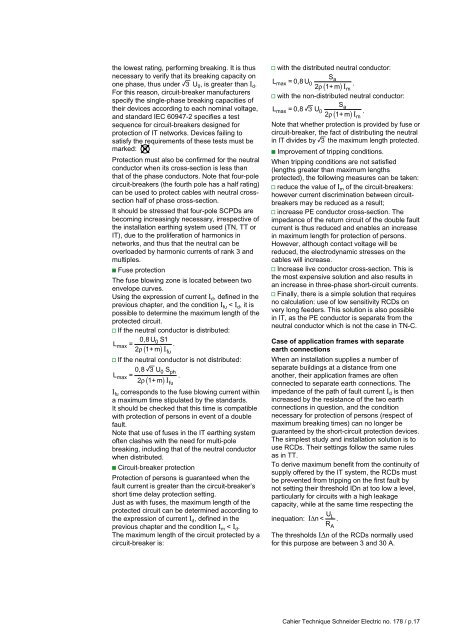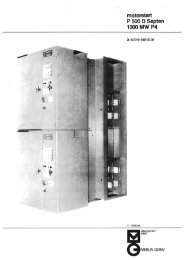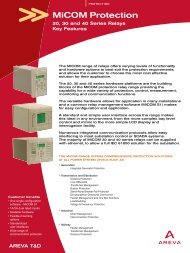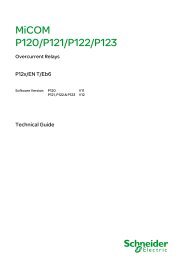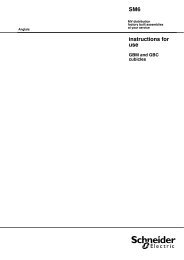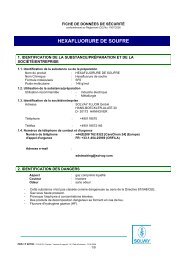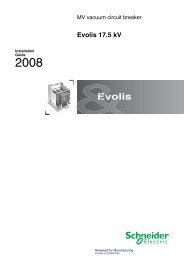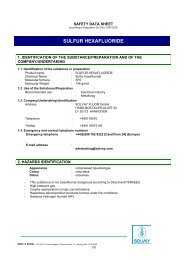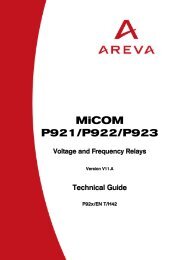The IT earthing system (unearthed neutral) in LV
The IT earthing system (unearthed neutral) in LV
The IT earthing system (unearthed neutral) in LV
Create successful ePaper yourself
Turn your PDF publications into a flip-book with our unique Google optimized e-Paper software.
the lowest rat<strong>in</strong>g, perform<strong>in</strong>g break<strong>in</strong>g. It is thusnecessary to verify that its break<strong>in</strong>g capacity onone phase, thus under e U 0 , is greater than I d .For this reason, circuit-breaker manufacturersspecify the s<strong>in</strong>gle-phase break<strong>in</strong>g capacities oftheir devices accord<strong>in</strong>g to each nom<strong>in</strong>al voltage,and standard IEC 60947-2 specifies a testsequence for circuit-breakers designed forprotection of <strong>IT</strong> networks. Devices fail<strong>in</strong>g tosatisfy the requirements of these tests must bemarked: <strong>IT</strong>Protection must also be confirmed for the neutralconductor when its cross-section is less thanthat of the phase conductors. Note that four-polecircuit-breakers (the fourth pole has a half rat<strong>in</strong>g)can be used to protect cables with neutral crosssectionhalf of phase cross-section.It should be stressed that four-pole SCPDs arebecom<strong>in</strong>g <strong>in</strong>creas<strong>in</strong>gly necessary, irrespective ofthe <strong>in</strong>stallation <strong>earth<strong>in</strong>g</strong> <strong>system</strong> used (TN, TT or<strong>IT</strong>), due to the proliferation of harmonics <strong>in</strong>networks, and thus that the neutral can beoverloaded by harmonic currents of rank 3 andmultiples.c Fuse protection<strong>The</strong> fuse blow<strong>in</strong>g zone is located between twoenvelope curves.Us<strong>in</strong>g the expression of current I d , def<strong>in</strong>ed <strong>in</strong> theprevious chapter, and the condition I fu < I d , it ispossible to determ<strong>in</strong>e the maximum length of theprotected circuit.v If the neutral conductor is distributed:L = 0,8 U 0 S 1max.2ρ ( 1+ m) Ifuv If the neutral conductor is not distributed:L = 0,8 e U 0 S phmax.1+ m2ρ ( ) I fuI fu corresponds to the fuse blow<strong>in</strong>g current with<strong>in</strong>a maximum time stipulated by the standards.It should be checked that this time is compatiblewith protection of persons <strong>in</strong> event of a doublefault.Note that use of fuses <strong>in</strong> the <strong>IT</strong> <strong>earth<strong>in</strong>g</strong> <strong>system</strong>often clashes with the need for multi-polebreak<strong>in</strong>g, <strong>in</strong>clud<strong>in</strong>g that of the neutral conductorwhen distributed.c Circuit-breaker protectionProtection of persons is guaranteed when thefault current is greater than the circuit-breaker’sshort time delay protection sett<strong>in</strong>g.Just as with fuses, the maximum length of theprotected circuit can be determ<strong>in</strong>ed accord<strong>in</strong>g tothe expression of current I d , def<strong>in</strong>ed <strong>in</strong> theprevious chapter and the condition I m < I d .<strong>The</strong> maximum length of the circuit protected by acircuit-breaker is:v with the distributed neutral conductor:SL =0,8U amax 02ρ ( 1+m) I.mv with the non-distributed neutral conductor:SL max =0,8eUa02 ρ ( 1+m ) I.mNote that whether protection is provided by fuse orcircuit-breaker, the fact of distribut<strong>in</strong>g the neutral<strong>in</strong> <strong>IT</strong> divides by e the maximum length protected.c Improvement of tripp<strong>in</strong>g conditions.When tripp<strong>in</strong>g conditions are not satisfied(lengths greater than maximum lengthsprotected), the follow<strong>in</strong>g measures can be taken:v reduce the value of I m of the circuit-breakers:however current discrim<strong>in</strong>ation between circuitbreakersmay be reduced as a result;v <strong>in</strong>crease PE conductor cross-section. <strong>The</strong>impedance of the return circuit of the double faultcurrent is thus reduced and enables an <strong>in</strong>crease<strong>in</strong> maximum length for protection of persons.However, although contact voltage will bereduced, the electrodynamic stresses on thecables will <strong>in</strong>crease.v Increase live conductor cross-section. This isthe most expensive solution and also results <strong>in</strong>an <strong>in</strong>crease <strong>in</strong> three-phase short-circuit currents.v F<strong>in</strong>ally, there is a simple solution that requiresno calculation: use of low sensitivity RCDs onvery long feeders. This solution is also possible<strong>in</strong> <strong>IT</strong>, as the PE conductor is separate from theneutral conductor which is not the case <strong>in</strong> TN-C.Case of application frames with separateearth connectionsWhen an <strong>in</strong>stallation supplies a number ofseparate build<strong>in</strong>gs at a distance from oneanother, their application frames are oftenconnected to separate earth connections. <strong>The</strong>impedance of the path of fault current I d is then<strong>in</strong>creased by the resistance of the two earthconnections <strong>in</strong> question, and the conditionnecessary for protection of persons (respect ofmaximum break<strong>in</strong>g times) can no longer beguaranteed by the short-circuit protection devices.<strong>The</strong> simplest study and <strong>in</strong>stallation solution is touse RCDs. <strong>The</strong>ir sett<strong>in</strong>gs follow the same rulesas <strong>in</strong> TT.To derive maximum benefit from the cont<strong>in</strong>uity ofsupply offered by the <strong>IT</strong> <strong>system</strong>, the RCDs mustbe prevented from tripp<strong>in</strong>g on the first fault bynot sett<strong>in</strong>g their threshold IDn at too low a level,particularly for circuits with a high leakagecapacity, while at the same time respect<strong>in</strong>g the<strong>in</strong>equation: I∆n


